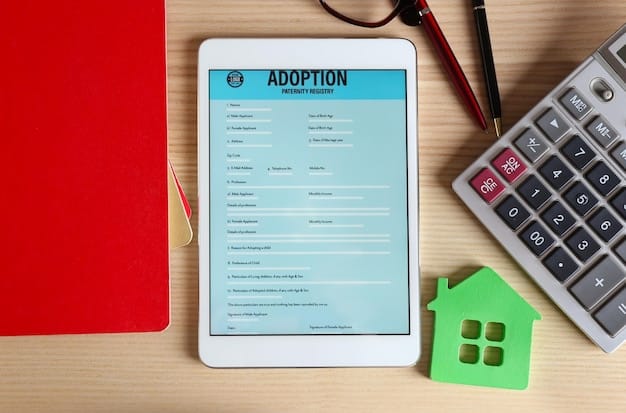Budgeting for Homeownership: A First-Time Buyer’s Guide

Budgeting for homeownership involves careful planning, saving for a down payment, understanding mortgage options, and accounting for ongoing expenses like property taxes, insurance, and maintenance to ensure financial stability.
Embarking on the journey of homeownership is an exciting milestone, but it also requires careful financial planning. Budgeting for homeownership: A comprehensive guide for first-time buyers will help you navigate the financial landscape, ensuring you’re prepared for the costs associated with buying and maintaining a home.
Understanding the True Cost of Homeownership
Many first-time homebuyers focus primarily on the mortgage payment, but the true cost of homeownership extends far beyond that. It’s crucial to understand all the expenses involved to create a realistic budget.
Down Payment and Closing Costs
Saving for a down payment is often the biggest hurdle for first-time buyers. While the standard is 20%, some loans allow for lower down payments, but this usually means paying private mortgage insurance (PMI).
Mortgage Options
Understanding different mortgage options is critical. Fixed-rate mortgages offer stability, while adjustable-rate mortgages (ARMs) may start with lower payments but can fluctuate over time. There are also FHA loans, VA loans, and conventional loans, each with its own requirements and benefits.

Beyond the down payment and mortgage, closing costs can add significantly to your initial expenses. These costs typically include:
- Appraisal fees
- Title insurance
- Loan origination fees
- Property taxes (prepaid)
Understanding these initial expenses will give you a clearer picture of how much you need to save before buying a home.
In conclusion, understanding the upfront costs such as the down payment, closing costs, and also knowing the different mortgage options are crucial for a first-time homebuyer’s budget. These are all important in the home buying process.
Creating a Realistic Monthly Budget
Once you’ve accounted for the initial costs, it’s time to create a realistic monthly budget that includes all ongoing expenses. Underestimating these costs can lead to financial strain down the road.
Principal, Interest, Taxes, and Insurance (PITI)
PITI is a common acronym that represents the four main components of your monthly housing payment. Principal and interest go towards paying off your mortgage, while property taxes and homeowners insurance are typically included in your monthly payment and held in escrow.
Keep in mind that property taxes and insurance rates can increase over time, so it’s important to factor in potential increases when creating your budget.
Utilities
Utilities can vary significantly depending on the size and location of your home. Common utilities include:
- Electricity
- Natural gas
- Water
- Sewer
- Trash removal
Research average utility costs in your area to get a better estimate of what to expect.
Maintenance and Repairs
Budgeting for maintenance and repairs is essential. Experts recommend setting aside 1% to 3% of your home’s value each year for these expenses. This can cover everything from minor repairs to major replacements, such as a new roof or HVAC system.
Other Potential Costs
Don’t forget to factor in other potential costs, such as:
- Homeowners association (HOA) fees
- Landscaping
- Pest control
- Security systems
Being thorough in your budgeting process will help you avoid financial surprises and ensure you can comfortably afford your home.
In summary, creating a budget that accounts for all monthly expenses of homeownership is necessary. Neglecting potential costs, like HOA fees, can lead to financial strain.
Assessing Your Affordability
Determining how much you can realistically afford is a crucial step in the home buying process. It’s important to look beyond the pre-approval amount and consider your overall financial situation.
Debt-to-Income Ratio (DTI)
Your DTI is the percentage of your gross monthly income that goes towards debt payments, including your mortgage, student loans, credit card debt, and car loans. Lenders typically prefer a DTI of 43% or less.
Credit Score
Your credit score plays a significant role in determining your interest rate. A higher credit score typically results in a lower interest rate, saving you money over the life of the loan.
Check your credit report for any errors and take steps to improve your credit score before applying for a mortgage.
Savings and Emergency Fund
Having a healthy savings account and an emergency fund is crucial for handling unexpected expenses. Aim to have at least three to six months’ worth of living expenses saved.

Long-Term Financial Goals
Consider your long-term financial goals, such as retirement savings and college funds for your children. Make sure that buying a home aligns with these goals and doesn’t derail your financial future.
It’s important to realistically assess your affordability, considering factors beyond pre-approval thresholds. This includes checking your credit report, having a savings account, and also considering your long-term financial goals.
Saving Strategies for First-Time Homebuyers
Saving for a down payment can seem daunting, but with a strategic approach, it’s achievable. Here are some effective saving strategies for first-time homebuyers.
Create a Savings Plan
Start by creating a detailed savings plan. Set a specific savings goal and timeline, and track your progress regularly.
Cut Unnecessary Expenses
Identify areas where you can cut back on spending. This could include:
- Dining out less frequently
- Reducing entertainment expenses
- Canceling unused subscriptions
Automate Your Savings
Set up automatic transfers from your checking account to your savings account each month. This ensures that you’re consistently saving without having to actively think about it.
Explore First-Time Homebuyer Programs
Many states and local governments offer first-time homebuyer programs that provide down payment assistance, grants, or low-interest loans. Research these programs to see if you qualify.
Effective saving strategies include creating a savings plan, cutting unnecessary expenses, automating your savings, and exploring first-time homebuyer programs.
Navigating Mortgage Pre-Approval and Loan Options
Getting pre-approved for a mortgage is a crucial step in the home buying process. It gives you a clear understanding of how much you can borrow and strengthens your offer when you find a home.
Gather Required Documents
To get pre-approved, you’ll need to provide several documents, including:
- Proof of income (pay stubs, W-2s)
- Bank statements
- Tax returns
- Credit report
Shop Around for the Best Rates
Don’t settle for the first mortgage offer you receive. Shop around with different lenders to compare interest rates and fees. Even a small difference in interest rate can save you thousands of dollars over the life of the loan.
Understand Loan Types
Familiarize yourself with different loan types, such as:
- Fixed-rate mortgages
- Adjustable-rate mortgages (ARMs)
- FHA loans
- VA loans
- Conventional loans
Consider a Mortgage Broker
A mortgage broker can help you navigate the loan process and find the best loan options for your situation. They work with multiple lenders and can save you time and effort.
Navigating the mortgage pre-approval process involves gathering required documents, shopping around for the best rates, understanding loan types, and considering a mortgage broker.
Long-Term Financial Planning After Buying a Home
The financial journey doesn’t end once you buy a home. Long-term financial planning is essential to ensure you can maintain your home and achieve your other financial goals.
Building Equity
Building equity in your home is a key component of long-term financial planning. Equity is the difference between your home’s value and the amount you owe on your mortgage. You can build equity by making mortgage payments and through home appreciation.
Refinancing
Consider refinancing your mortgage if interest rates drop. Refinancing can lower your monthly payment and save you money over the life of the loan.
Investing in Home Improvements
Investing in home improvements can increase your home’s value and make it more comfortable to live in. Focus on improvements that offer a good return on investment, such as kitchen or bathroom renovations.
Ongoing Budget Review
Regularly review your budget to ensure it still aligns with your financial goals. Adjust your budget as needed to account for changes in income, expenses, or interest rates.
Long-term financial planning after buying a home involves building equity, considering refinancing when rates drop, investing in home improvements, and doing an ongoing budget review.
| Key Point | Brief Description |
|---|---|
| 💰 Saving for Down Payment | Strategies for accumulating the necessary funds. |
| 🏡 Understanding PITI | Principal, Interest, Taxes, and Insurance are main components. |
| 📊 Assessing Affordability | Consider DTI, credit score, savings, and financial goals. |
| 📝 Long-Term Planning | Build equity through mortgage payments, review budget regularly. |
Frequently Asked Questions (FAQ)
▼
The standard is 20% of the home’s purchase price, but some loans allow for lower down payments, such as 3% to 5%. However, you’ll likely need to pay private mortgage insurance (PMI) if your down payment is less than 20%.
▼
DTI is the percentage of your gross monthly income that goes towards debt payments, including your mortgage, student loans, credit card debt, and car loans. Lenders typically prefer a DTI of 43% or less.
▼
Closing costs are fees associated with buying a home, such as appraisal fees, title insurance, loan origination fees, and prepaid property taxes. They typically range from 2% to 5% of the home’s purchase price.
▼
PMI is insurance that protects the lender if you default on your mortgage. It’s typically required if your down payment is less than 20% of the home’s purchase price. PMI is usually added to your monthly mortgage payment.
▼
To improve your credit score, pay your bills on time, reduce your credit card balances, avoid opening too many new accounts, and check your credit report for errors. Correcting any errors can help improve your score.
Conclusion
Budgeting for homeownership: A comprehensive guide for first-time buyers requires careful planning and disciplined saving. By understanding the true costs, creating a realistic budget, and implementing effective saving strategies, you can achieve your dream of homeownership while maintaining financial stability.





